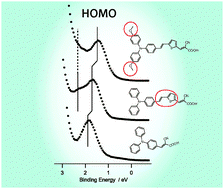Mapping the frontier electronic structures of triphenylamine based organic dyes at TiO2 interfaces
Abstract
The frontier electronic structures of a series of organic

* Corresponding authors
a
Molecular and Condensed Matter Physics, Department of Physics and Astronomy, Uppsala University, Box 516, SE-751 20 Uppsala, Sweden
E-mail:
Hakan.Rensmo@fysik.uu.se
Fax: +46 18 471 5999
Tel: +46 18 471 3547
b Department of Physics, Stockholm University, AlbaNova University Center, 106 91 Stockholm, Sweden
c Department of Physics, Chemistry and Biology (IFM), Thin Film Physics Division, Linköping University, SE-581 83 Linköping, Sweden
d Department of Physical and Analytical Chemistry, Uppsala University, Box 259, 751 05 Uppsala, Sweden
e Center of Molecular Devices, Royal Institute of Technology, Chemical Science and Engineering, Organic Chemistry, 100 44 Stockholm, Sweden
The frontier electronic structures of a series of organic

 Please wait while we load your content...
Something went wrong. Try again?
Please wait while we load your content...
Something went wrong. Try again?
M. Hahlin, M. Odelius, M. Magnuson, E. M. J. Johansson, S. Plogmaker, D. P. Hagberg, L. Sun, H. Siegbahn and H. Rensmo, Phys. Chem. Chem. Phys., 2011, 13, 3534 DOI: 10.1039/C0CP01491E
To request permission to reproduce material from this article, please go to the Copyright Clearance Center request page.
If you are an author contributing to an RSC publication, you do not need to request permission provided correct acknowledgement is given.
If you are the author of this article, you do not need to request permission to reproduce figures and diagrams provided correct acknowledgement is given. If you want to reproduce the whole article in a third-party publication (excluding your thesis/dissertation for which permission is not required) please go to the Copyright Clearance Center request page.
Read more about how to correctly acknowledge RSC content.
 Fetching data from CrossRef.
Fetching data from CrossRef.
This may take some time to load.
Loading related content
